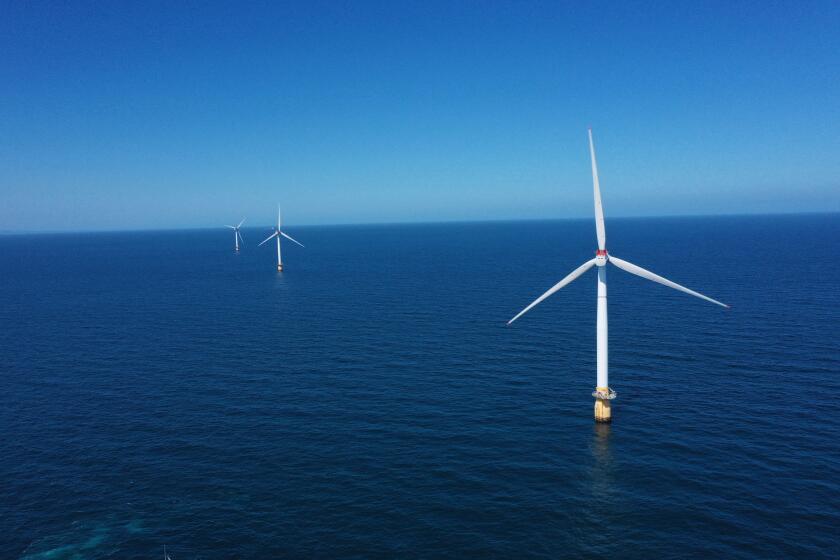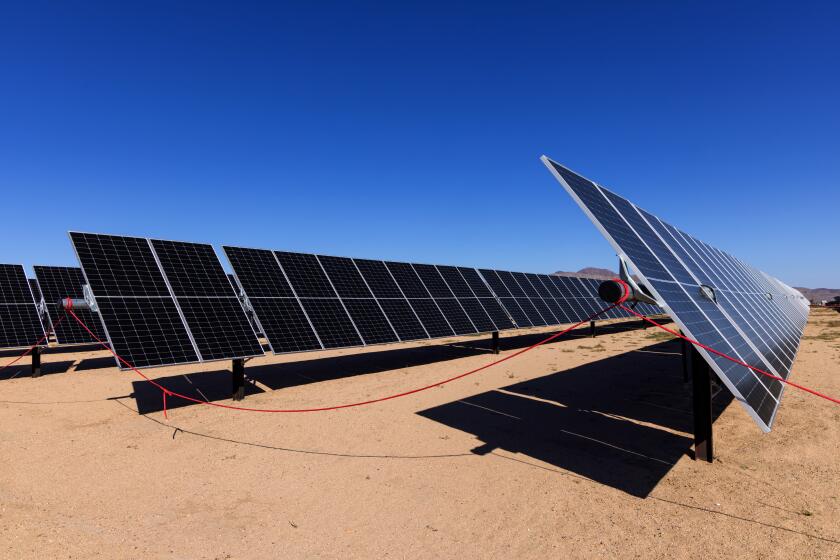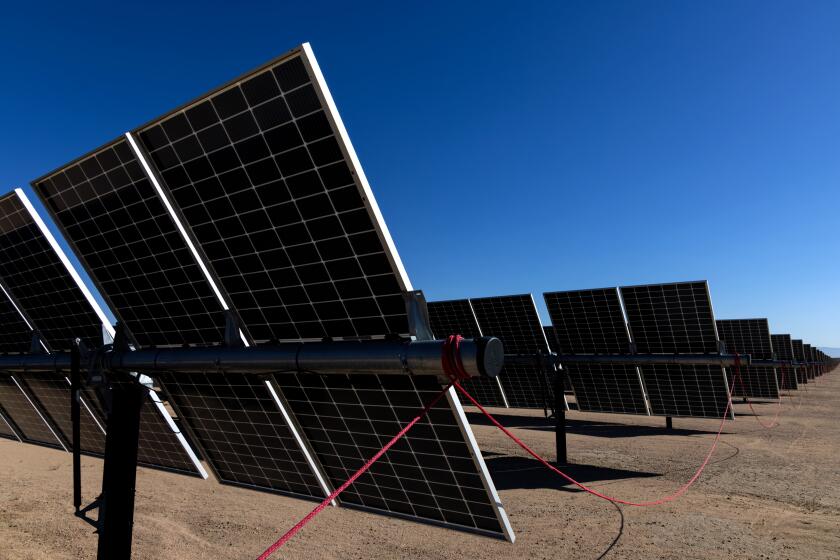As California leans into offshore wind power, do problems on the East Coast raise caution flags?

- Share via
Although multiple offshore wind energy projects on the East Coast have been jeopardized or pulled off the table, California policymakers say they remain confident that a veritable bonanza of electrical power will be captured off the coast of the Golden State.
“I see it as a fundamental piece of our energy policy over the next 30 years in California,” said David Hochschild, chair of the California Energy Commission.
To help meet the state’s target of deriving 100% of its electricity from carbon-free sources by 2045, California energy officials have set goals for offshore wind to generate as much as 5 gigawatts of power by 2030 and 25 gigawatts by 2045. For perspective, the Diablo Canyon nuclear plant in San Luis Obispo produces 2.2 gigawatts of capacity, which accounts for about 9% of the state’s power mix each year.
Creating a California offshore wind industry from scratch will be a major technological, logistical and financial challenge, but it’s a crucial component to a state electric grid that looks to increasingly rely on renewable energy sources.
Solar power generation is abundant during the daylight hours, but as the sun goes down, the grid comes under strain, especially on hot days when customers across the state crank up their air conditioners. Megawatts of power from natural gas plants help fill in the gaps, but natural gas is a fossil fuel.
A deal struck by Gov. Gavin Newsom and state lawmakers could lead to huge floating turbines off the coast.
Offshore wind, on the other hand, does not emit greenhouse gases. Plus, the California Energy Commission says studies indicate that production from offshore wind is strong between the crucial hours of 4 and 9 p.m., when the grid needs it the most.
“The characteristics of this clean energy resource that we have right off our coast complements the onshore wind and solar that we already have,” said Adam Stern, executive director of Offshore Wind California, an industry trade group.
But problems have cropped up in recent months in the Northeast.
Orsted, a Danish multinational energy company and major player in the wind energy industry, recently canceled two wind farms along the coast of New Jersey. The Wall Street Journal reported that the company may need to cancel more projects to shore up its balance sheet.
BP and Equinor have threatened to pull out of offshore projects in New York, leading state officials to reopen the bidding process.

The trouble stems from higher interest rates that have increased financial costs, plus inflation that has driven up prices for turbines, steel and labor costs.
But at a two-day offshore wind conference in San Diego recently, developers said they’re still bullish on building projects in California and on the West Coast.
“We are here for the long term,” Martin Goff, Equinor’s project director for offshore wind in California, said during a break at the conference, sponsored by Reuters. “We want to develop an industry out here — it’s not just one project.”
Equinor is one of five companies that collectively bid $751.1 million last year to lease tens of thousands of acres off the coast of California in an auction overseen by the federal government.
Goff said the company’s Hywind Tampen facility that supplies electricity to Equinor’s oil and gas fields in the Norwegian North Sea is the largest floating wind farm in the world.
We need as much renewable energy as we can get, as fast as we can get it. Even if that’s painful.
“It’s proven technology,” Goff said.
Unlike on the East Coast, where turbines can be bolted into the seabed, the continental shelf off the coast of the Pacific plunges steeply.
That means offshore wind farms in California must float on the water’s surface, tethered or moored by cables to the ocean floor. Electricity generated by turbines will be transmitted to a floating substation and carried to a power plant onshore via buried cables, adding layers of complexity and expense.
California will be the first region in the U.S. to use floating wind turbines.
The potential technical challenges, combined with the recent financial headlines out of the Northeast, have fueled arguments from skeptics.
The numbers are encouraging for renewable energy. But they don’t tell the full story.
“If it’s not going to work on the East Coast, it’s not going to work in California,” said Robert Bryce, author of several books on energy and a vocal wind industry critic. “Anytime you put anything in saltwater, the cost goes up by a factor of 2, 3, 4 times. It’s a hostile environment. ... It’s expensive, it’s intermittent, it’s not durable.”
Hochschild, of the California Energy Commission, said, “I wouldn’t lose the forest for the trees.”
“With all clean energy technologies in the market today, the long-term price trend is downward,” he said. “But it’s marked by periodic departures from that and upward ticks, which we’re seeing now in offshore wind for the moment because of emerging issues.”
Although final designs are still to be submitted, the turbines will soar hundreds of feet high, with blades larger than a football field to harvest the maximum amount of wind. Hochschild said the offshore leases in California are located on sites 20 to 60 miles from the mainland.
The wind farms are proposed to be built off the coasts of Morro Bay in Central California and Humboldt County in Northern California.
There are no plans to build offshore wind projects off the Southern California coast.
Wind speeds in the south are not as steady and strong as the breezes in Central and Northern California. Plus, military officials, in discussions with the Bureau of Ocean Energy Management, designated Southern California a “wind exclusion” area because they worry that offshore wind facilities would interfere with training missions.
That said, San Diego’s General Dynamics NASSCO announced earlier this year that it will compete for contracts to build the installation and support ships that will be needed to create the turbines for West Coast offshore projects, with a focus on California.
The company will do so in a partnership with Navantia, a Spanish state-owned shipbuilder that already has experience in the offshore wind energy market.
Nikolewski writes for the San Diego Union-Tribune. Union-Tribune staff writer Gary Robbins contributed to this report.
More to Read
Inside the business of entertainment
The Wide Shot brings you news, analysis and insights on everything from streaming wars to production — and what it all means for the future.
You may occasionally receive promotional content from the Los Angeles Times.













